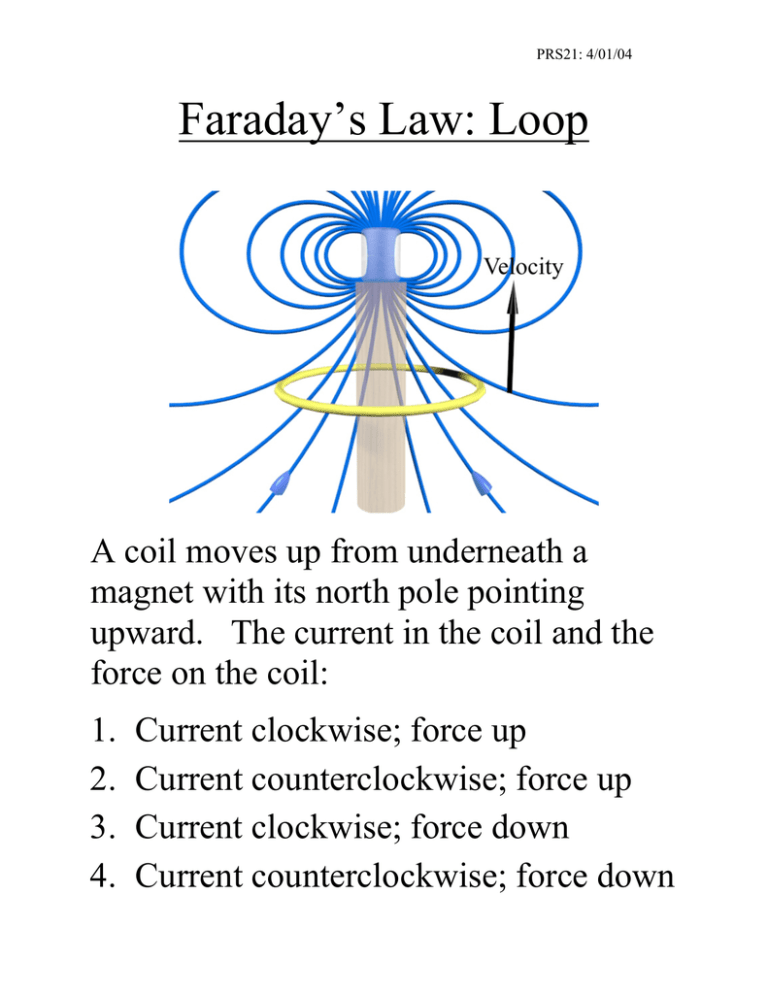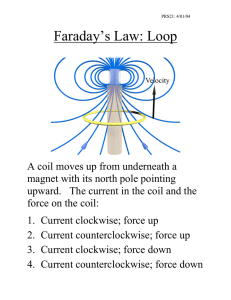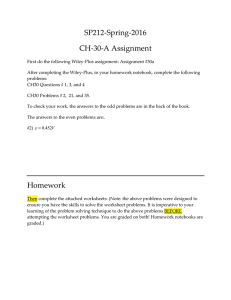Document 13604355
advertisement

PRS21: 4/01/04 Faraday’s Law: Loop A coil moves up from underneath a magnet with its north pole pointing upward. The current in the coil and the force on the coil: 1. 2. 3. 4. Current clockwise; force up Current counterclockwise; force up Current clockwise; force down Current counterclockwise; force down PRS21: 4/01/04 Faraday’s Law: Loop (3) Current is clockwise; force is down The clockwise current creates a self-field downward, trying to offset the increase of magnetic flux through the coil as it moves upward into stronger fields (Lenz’s Law). The I ds x B force on the coil is a force which is trying to keep the flux through the coil from increasing by slowing it down (Lenz’s Law again). PRS21: 4/01/04 Faraday’s Law: Rails A conducting rod moves along conducting rails in a magnetic field which is out of the page. The current in the rod and the force on the rod are: 1. Current up and force to left 2. Current down and force to left 3. Current up and force to right 4. Current down and force to right PRS21: 4/01/04 Faraday’s Law: Rails (3) Current is up; force on rod is to right. The clockwise current creates a self-field into the page – the current tries to offset the increase of magnetic flux in the loop due to the moving rod (Lenz’s Law). The I ds x B force on the rod is a force which is trying to keep the flux through the circuit from increasing by slowing the rod down (Lenz’s Law again). PRS21: 4/01/04 Faraday’s Law: Loop A circuit in the form of a rectangular piece of wire is pulled away from a long wire carrying current I in the direction shown in the sketch. The induced current in the rectangular circuit is 1. Clockwise 2. Counterclockwise 3. Neither, the current is zero PRS21: 4/01/04 Faraday’s Law: Loop (1) Clockwise. The magnetic field due to the current in the long wire is into the page, and the flux through the rectangular circuit due to that field decreases as the circuit moves away. So the induced current is clockwise, so as to generate an induced B field into the page that is trying to keep the magnetic flux into the page from decreasing. Note: I ds x B force is left on the left segment and right on the right, but the force on the left is bigger. So the net force on the rectangular circuit is to the left, again trying to keep the flux from decreasing by slowing the circuit’s motion. PRS21: 4/01/04 Faraday’s Law: Generator A square coil rotates in a magnetic field directed to the right. At the time shown, the current in the square, when looking down from the top of the square loop, will be 1. Counterclockwise. 2. Clockwise PRS21: 4/01/04 Faraday’s Law: Generator (1) Current is counterclockwise. The flux through the loop decreases as the normal rotates away from the B field. To try to keep that flux from decreasing, the induced current in the square will be CCW, to produce an induced B field in the loop along the normal in the loop and therefore trying to keep the magnetic flux from decreasing (Lenz’s Law) The I ds x B force on the sides of the square loop will be such as to produce a torque that tries to stop if from rotating (Lenz’s Law). PRS21: 4/01/04 Loop in Uniform Field Bout v A rectangular wire loop is pulled thru a uniform magnetic field penetrating its top half, as shown. The induced current and the force and torque on the loop are: 1. Current CW, Force Left, No Torque 2. Current CW, No Force, Torque Rotates CCW 3. Current CCW, Force Left, No Torque 4. Current CCW, No Force, Torque Rotates CCW 5. No current, force or torque PRS21: 4/01/04 Loop in Uniform Field Bout v (5) No current, force or torque. The motion does not change the magnetic flux, so Faraday’s Law says there is no induced EMF, or current, or force, or torque. Of course, if we were pulling at all up or down there would be a force to oppose that motion.









